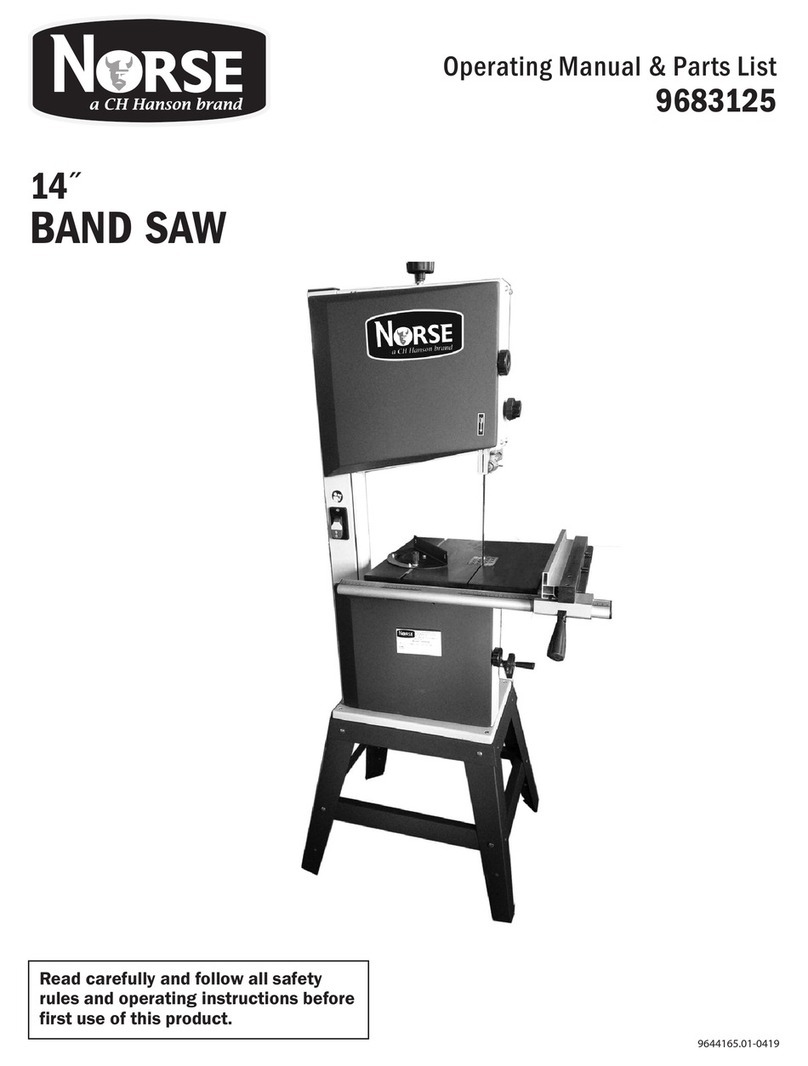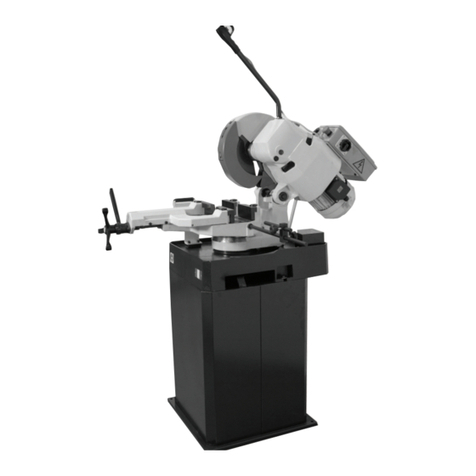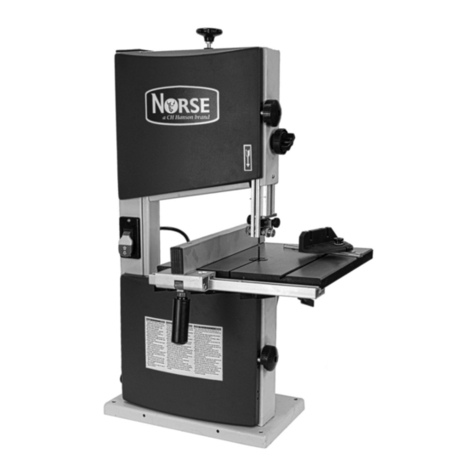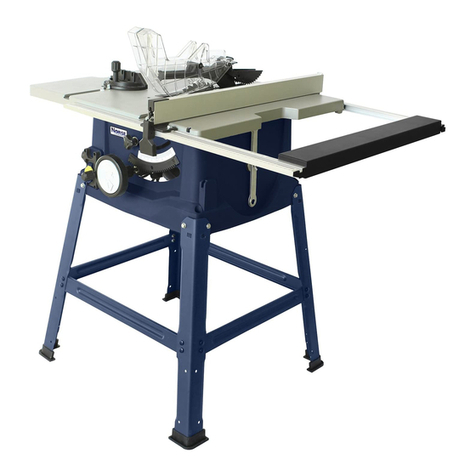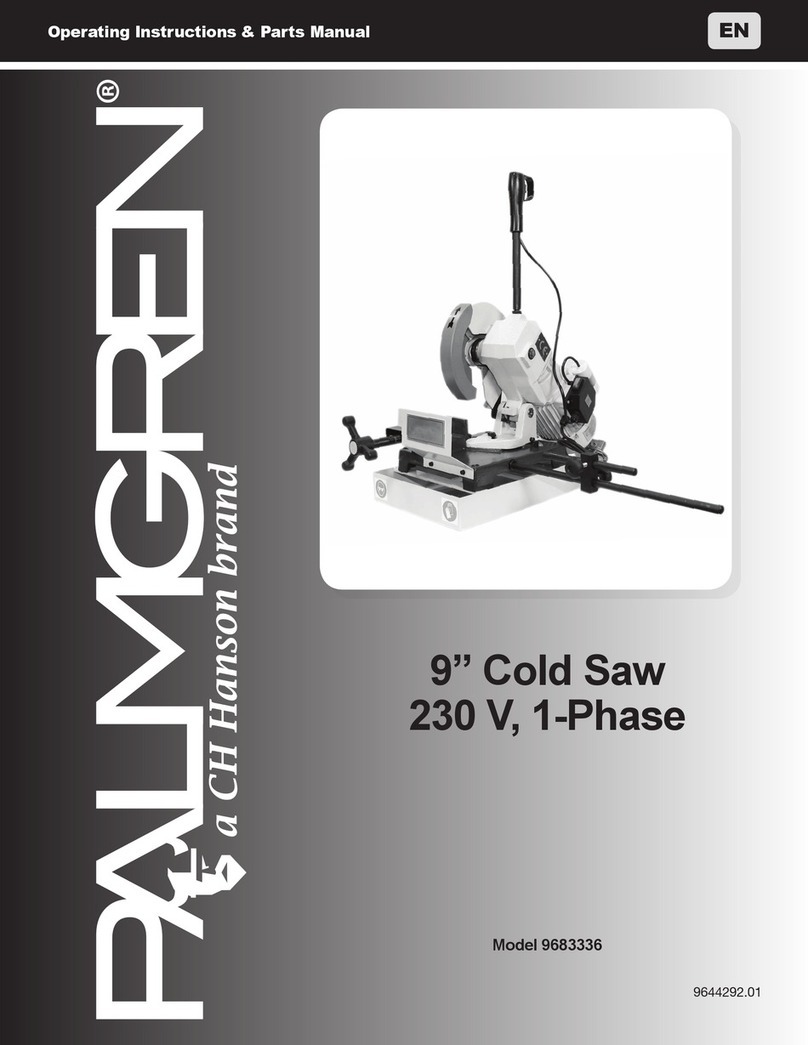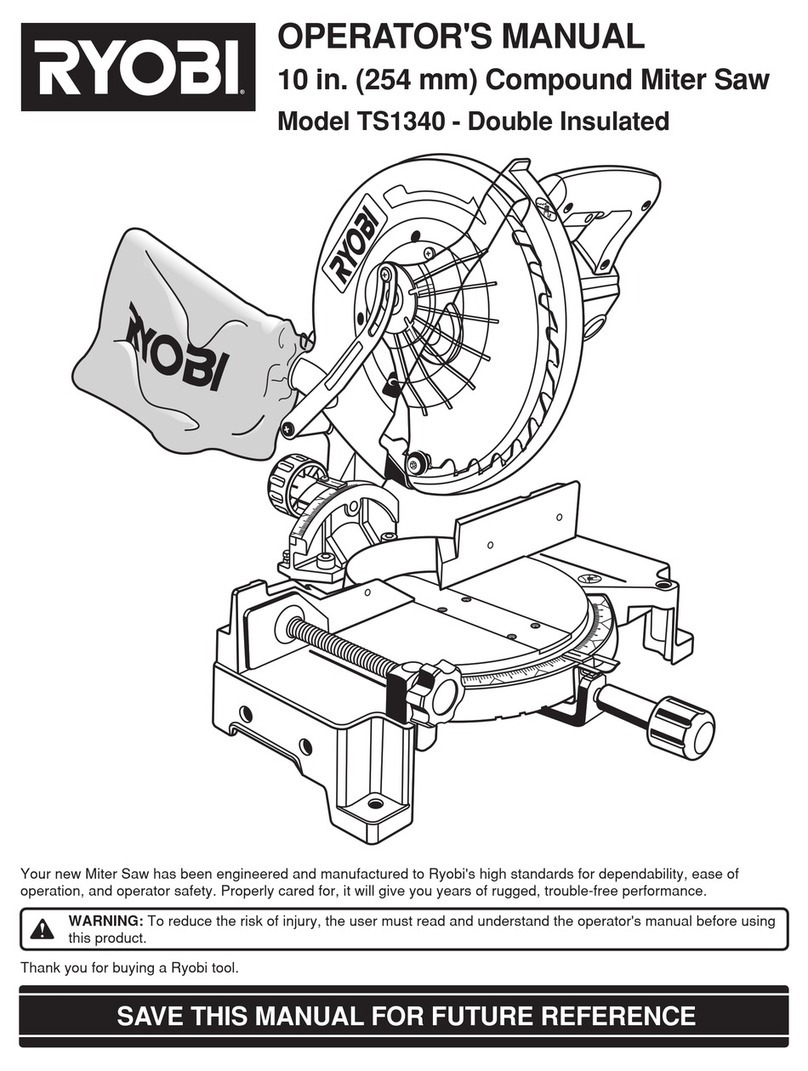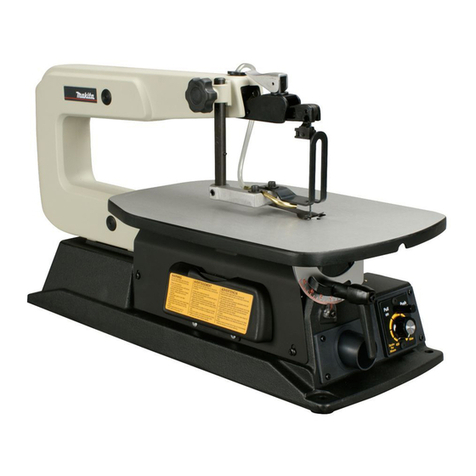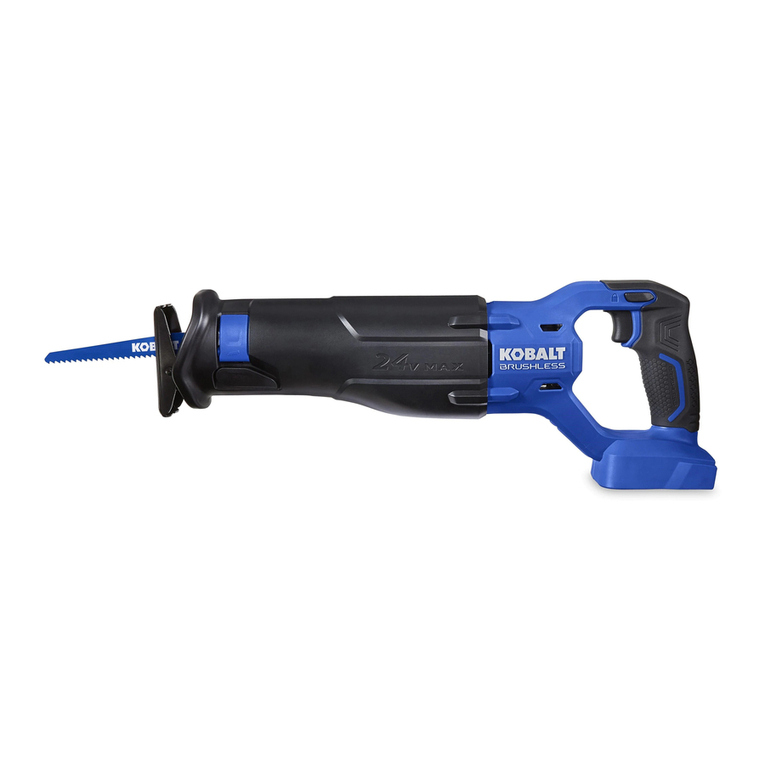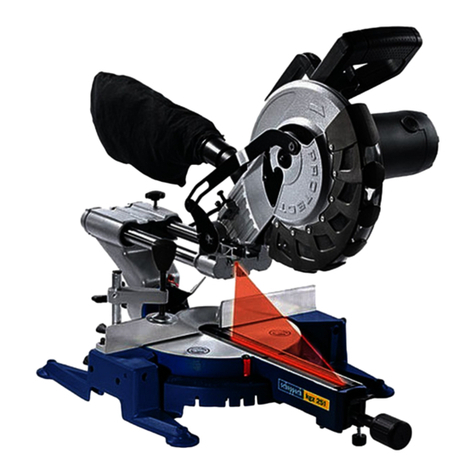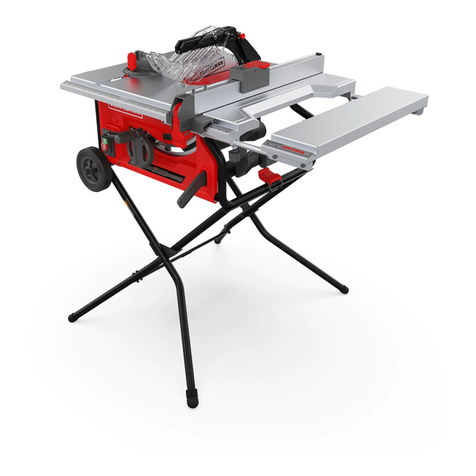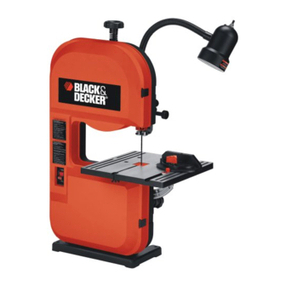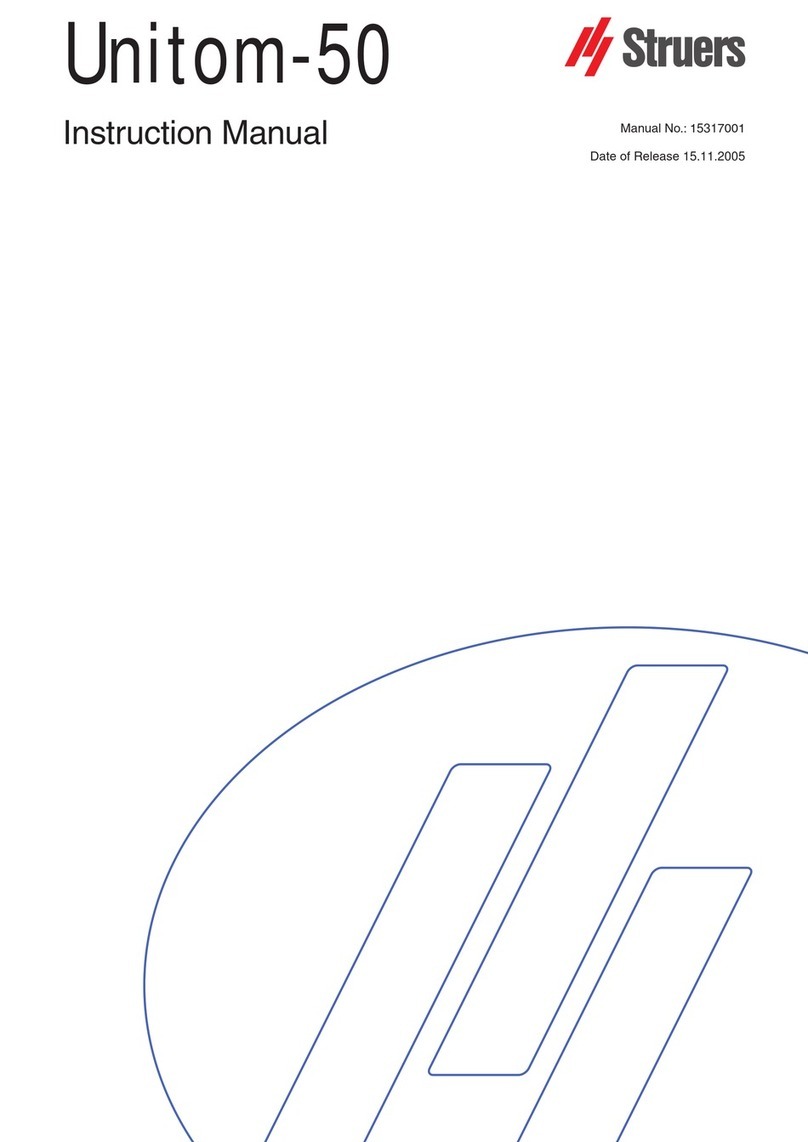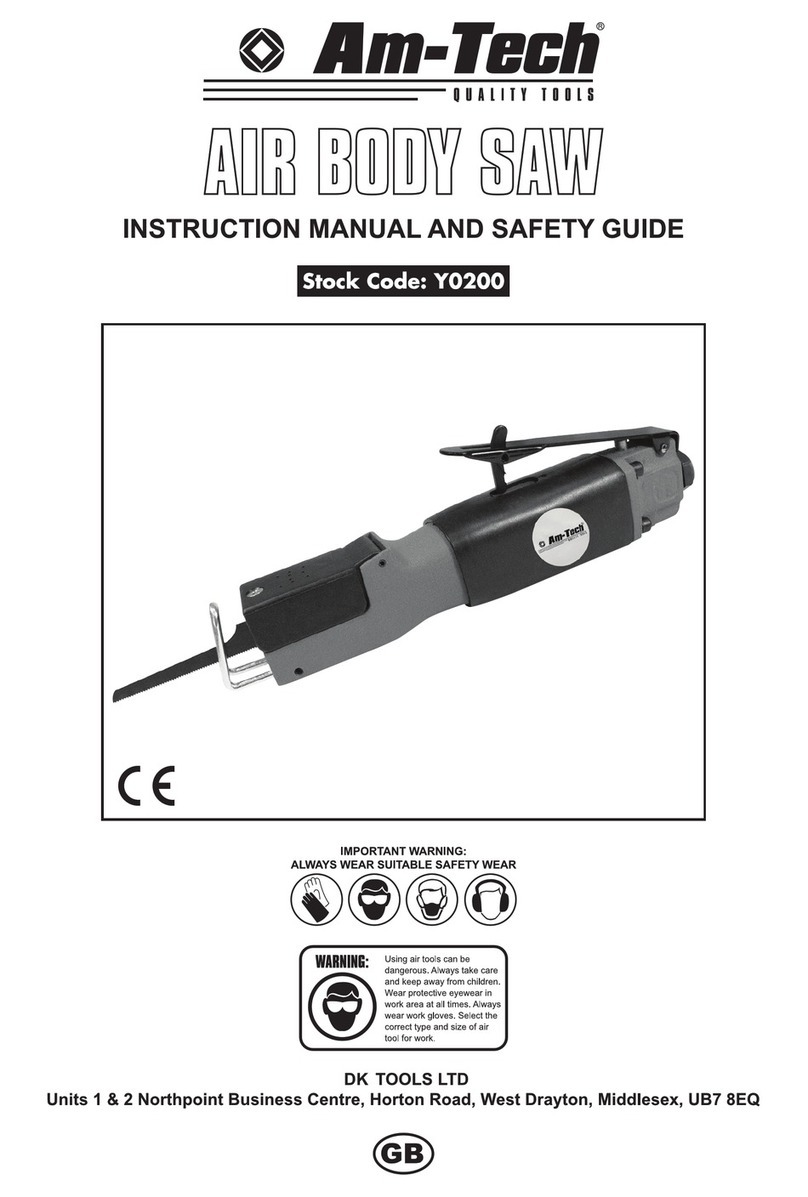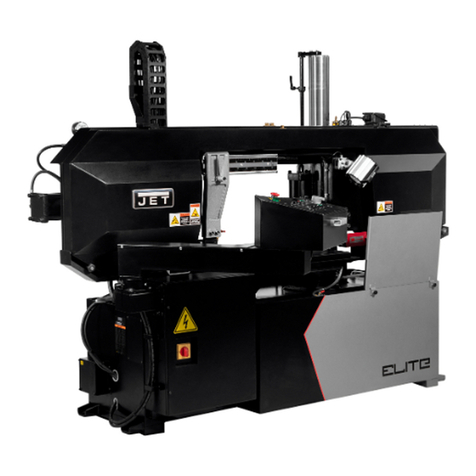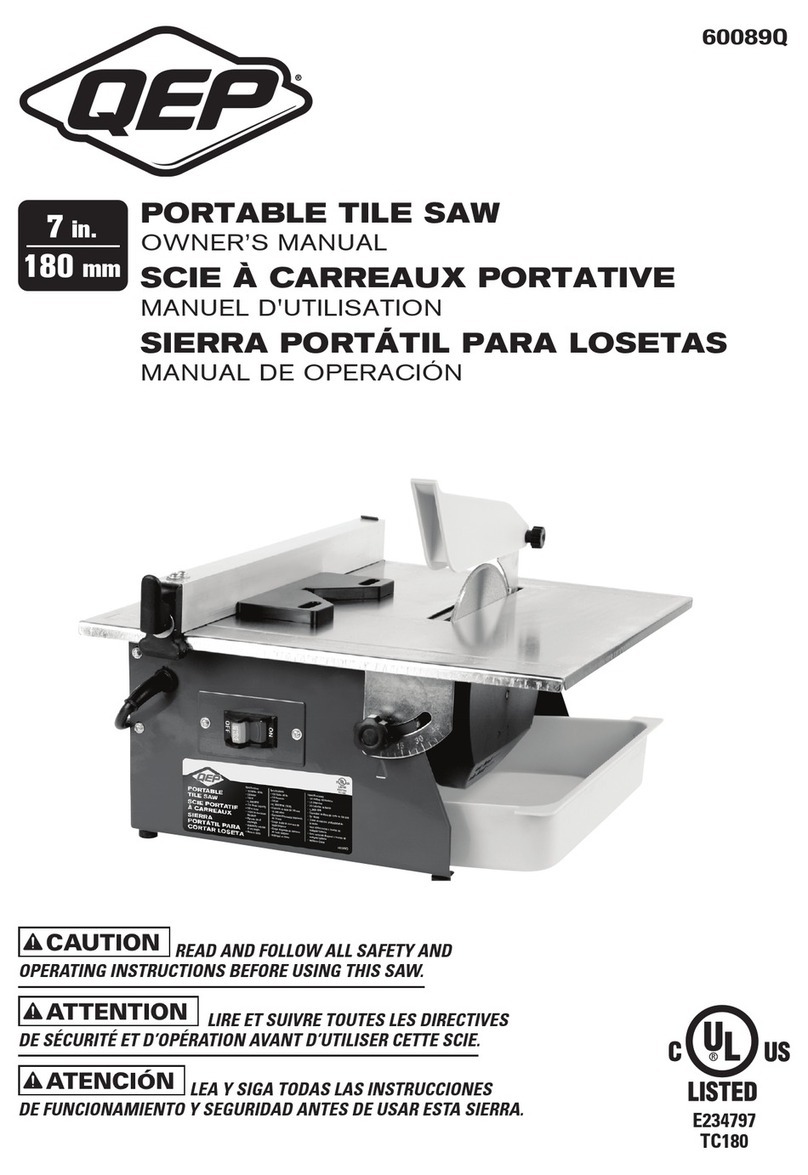CH Hanson NORSE 9683113 User manual

Operating Manual & Parts List
9683113
15˝
7 Speed Metal/Wood Cutting
BAND SAW
Read carefully and follow all safety
rules and operating instructions before
first use of t is product.
9644206.01-0519

2
NORSE Operating Manual & Parts List 9683113
GETTING STARTED
DESCRIPTIO
The NORSE 15˝ Metal/Wood Cutting Band Saw is for cutting ferrous
and non-ferrous metals and also hard and soft woods. The band
saw features a unitized frame of welded steel construction and a
solid cast iron work surface to ensure durability. Table tilts 45° and
has a miter gauge and precision machined rip fence for performing
many different operations. Fifteen inch balanced cast iron wheels
with ball bearings and rubber treads accommodate blade widths
up to 3/4˝. A convenient tensioning and tracking mechanism
makes blade changing quick and easy. Rip fence and miter gauge
can be stored on the saw when not in use.
U PACKI G
Check for shipping damage. If damage has occurred, a claim must
be filed with carrier. Check for completeness. Immediately report
missing parts to dealer.
The band saw comes assembled as one unit. Additional parts which
need to be fastened to the saw should be located and accounted
for before assembling:
A Table Assembly
B Rip Fence with Knob
C Miter Gauge Assembly
D V-belt
E Metal Cutting Blade, 14 TPI
F Wood Cutting Blade, 6 TPI
G Dust Chute
ardware Bag (Part No. 24958.00) includes:
Trunnion Rod with Acorn Nut
I Knob with Internal Threads
J andle
K Front Trunnion
• 5/16˝ Flat Washer (3)
• 8-1.25 x 20mm Socket ead Bolt (2)
• 8mm Lock Washer (2)
• 8/10mm Open End Wrench (1)
• 12/14mm Open End Wrench (1)
• 2.5, 3mm and 5mm ex Wrench (1 each)
• 5-0.8 x 8mm Pan ead Screw (4).
IMPORTANT: Table is coated with a protectant. To ensure proper fit
and operation, remove coating. Coating is easily removed with mild
solvents, such as mineral spirits, and a soft cloth. Avoid getting solu-
tion on paint or any of the rubber or plastic parts. Solvents may de-
teriorate these finishes. Use soap and water on paint, plastic or
rubber components. After cleaning, cover all exposed surfaces with
a light coating of oil. Paste wax is recommended for table top.
WAR I G: Never use highly volatile solvents. Non flammable
solvents are recommended to avoid possible fire hazard.
SPECIFICATIONS
Depth of throat . . . . . . . . . . . . . . . . . . . . . . . . . . . . . . . . . . . . . . . . . . . . . 14 ¾˝
Maximum depth of cut . . . . . . . . . . . . . . . . . . . . . . . . . . . . . . . . . . . . . 10 ¼˝
Maximum depth of cut at 45° . . . . . . . . . . . . . . . . . . . . . . . . . . . . . . . . 6 ½˝
Table size . . . . . . . . . . . . . . . . . . . . . . . . . . . . . . . . . . . . . . . . . . . . . . . . 15 × 15˝
Table tilt . . . . . . . . . . . . . . . . . . . . . . . . . . . . . . . . . . . . . . . . 10° left - 45° right
Wheel diameter . . . . . . . . . . . . . . . . . . . . . . . . . . . . . . . . . . . . . . . . . . . . . . . 15˝
Blade length . . . . . . . . . . . . . . . . . . . . . . . . . . . . . . . . . . . . . . . . . . . . . . . . . 113˝
Blade range . . . . . . . . . . . . . . . . . . . . . . . . . . . . . . . . . . . . . . . . . . . . 112 – 114˝
Blade width . . . . . . . . . . . . . . . . . . . . . . . . . . . . . . . . . . . . . . . . . . 3/16 to 3/4˝
Blade speeds . . . . . . . . . . . . . . . 45, 65, 90, 110, 155, 215 and 3,000 FPM
Overall dimensions (W × D × ) . . . . . . . . . . . . . . . . . . . . 25 × 27 × 71.5˝
Weight . . . . . . . . . . . . . . . . . . . . . . . . . . . . . . . . . . . . . . . . . . . . . . . . . . . 300 lbs
Crate dimension (W × D × ) . . . . . . . . . . . . . . . . . . . . . . . . 23 × 23 × 78˝
Shipping weight . . . . . . . . . . . . . . . . . . . . . . . . . . . . . . . . . . . . . . . . . . 346 lbs
Dust collection port . . . . . . . . . . . . . . . . . . . . . . . . . . . . . . . . . . . . . . . . . . . . 4˝
SAFETY RULES
WAR I G: For your own safety, read all of the instructions and
precautions before operating tool.
PROPOSITIO 65 WAR I G: Some dust created by using power
tools contain chemicals known to the state of California to cause
cancer, birth defects or other reproductive harm.
Some examples of these chemicals are:
• Lead from lead-based paints.
• Crystalline silica from bricks and cement and other masonry
products.
• Arsenic and chromium from chemically-treated lumber.
Your risk from these exposures varies, depending on how often you
do this type of work. To reduce your exposure to these chemicals:
work in a well ventilated area and work with approved safety
equipment. Always wear OSHA/ IOSH approved, properly fitting
face mask or respirator when using such tools.
WAR I G: Always follow proper operating procedures as
defined in this manual even if you are familiar with the use of this
or similar tools. Remember that being careless for even a fraction
of a second can result in severe personal injury.
BE PREPARED FOR JOB
• Wear proper apparel. Do not wear loose clothing, gloves, neck-
ties, rings, bracelets or other jewelry which may get caught in
moving parts of machine.
• Wear protective hair covering to contain long hair.
• Wear safety shoes with non-slip soles.
• Wear safety glasses complying with United States ANSI Z87.1.
Everyday glasses have only impact resistant lenses. They are
OT safety glasses.
• Wear face mask or dust mask if operation is dusty.
I
K
F
E
D
G
BC
A
J
Figure 1 - Unpacking

3
NORSE Operating Manual & Parts List 9683113
SAFETY RULES (CONTINUED)
• Be alert and think clearly. Never operate power tools when tired,
intoxicated or when taking medications that cause drowsiness.
PREPARE WORK AREA FOR JOB
• Keep work area clean. Cluttered work areas invite accidents.
• Do not use power tools in dangerous environments. Do not use
power tools in damp or wet locations. Do not expose power
tools to rain.
• Work area should be properly lighted.
• Proper electrical receptacle should be available for tool. Three-
prong plug should be plugged directly into properly grounded,
three-prong receptacle.
• Extension cords should have a grounding prong and the three
wires of the extension cord should be of the correct gauge.
• Keep visitors at a safe distance from work area.
• Keep children out of workplace. Make workshop childproof. Use
padlocks, master switches or remove switch keys to prevent any
unintentional use of power tools.
TOOL SHOULD BE MAI TAI ED
• Always unplug tool prior to inspection.
• Consult manual for specific maintaining and adjusting proce-
dures.
• Keep tool lubricated and clean for safest operation.
• Remove adjusting tools. Form habit of checking to see that ad-
justing tools are removed before switching machine on.
• Keep all parts in working order. Check to determine that the
guard or other parts will operate properly and perform their in-
tended function.
• Check for damaged parts. Check for alignment of moving parts,
binding, breakage, mounting and any other condition that may
affect a tool’s operation.
• Damaged parts should be properly repaired or replaced. Do not
perform makeshift repairs. (Use the parts list provided to order
replacement parts.)
K OW HOW TO USE TOOL
• Use right tool for job. Do not force tool or attachment to do a
job for which it was not designed.
• Disconnect tool when changing the blade.
• Avoid accidental start-up. Make sure that the tool is in the OFF
position before plugging in.
• Do not force tool. It will work most efficiently at the rate for
which it was designed.
• Keep hands away from moving parts and cutting surfaces.
• Never leave tool running unattended. Turn the power off and do
not leave tool until it comes to a complete stop.
• Do not overreach. Keep proper footing and balance.
• Never stand on tool. Serious injury could occur if tool is tipped
or if blade is unintentionally contacted.
• Know your tool. Learn the tool’s operation, application and spe-
cific limitations.
• Use recommended accessories. Use of improper accessories
may cause risk of injury to persons.
• andle workpiece correctly. Protect hands from possible injury.
• Turn the machine off if it jams. Blade jams when it digs too
deeply into the workpiece. (The motor force keeps it stuck in
workpiece). Do not remove jammed or cut off pieces until the
saw is turned off, unplugged and the blade has stopped.
WAR I G: The operation of any power tool can result in foreign
objects being thrown into the eyes, which can result in severe eye
damage. Always wear safety goggles complying with United States
ANSI Z87.1 before commencing power tool operation.
ASSEMBLY
Refer to Figures 2 and 6 – 11 (pages 4, 7 and 10 – 18).
CAUTIO : Do not attempt assembly if parts are missing. Use
operator’s manual to order replacement parts.
I STALL METAL CUTTI G BLADE
Refer to Figures 2, 8 and 9.
• Make sure blade teeth are pointing down towards table. Turn
blade inside out if necessary.
• Rotate handwheel (Figure 8, Ref. No. 23) counterclockwise to
move blade wheels towards each other.
• Loosen handle (Figure 9, Ref. No. 30). Rotate handwheel (Figure
9, Ref. No. 22) to lower upper blade guide assembly as low as
possible.
• Loosen three screws (Figure 9, Ref. No. 5). Remove blade guards
(Figure 9, Ref. Nos. 4 and 38).
• Slip blade over upper and lower blade wheels, and center blade
on blade wheels. Slide blade in between blade guides.
• Rotate handwheel clockwise to tension blade.
• Replace blade guards and secure in place by tightening screws.
Raise upper blade guide assembly.
• Position clutch handle (Figure 8, Ref. No. 62) to “Metal”. See Figure 2.
NOTE: The blade must be tensioned and tracked, and the blade
guides must be adjusted before operation of the saw. Refer to
“Tensioning Blade”, “Tracking Blade” and “Blade Guides” in the
OPERATION section, page 6.
I STALL WOOD CUTTI G BLADE
Refer to figures 2, 7, 8, 9 and 11 (pages 4, 10, 12, 14 and 18).
• The V-belt (Figure 11, Ref. No. 44) must be installed first when
using the saw to cut wood.
• Loosen knob (Figure 7, Ref. No. 14). Place V-belt on motor and
drive pulleys (Figure 8, Ref. Nos. 46 and 50).
• Tension V-belt by pushing down on motor mount plate and
tightening knob. Belt is properly tensioned when light pressure
applied to midpoint of the belt produces about 1/2˝ deflection.
• Make sure blade teeth are pointing down towards table. Turn
blade inside out if necessary.
• Rotate handwheel (Figure 8, Ref. No. 23) counterclockwise to
move blade wheels towards each other.
• Loosen handle (Figure 9, Ref. No. 30). Rotate handwheel (Figure
9, Ref. No. 22) to lower upper blade guide assembly as low as
possible.
• Loosen three screws (Figure 9, Ref. No. 5). Remove blade guards
(Figure 9, Ref. Nos. 4 and 38).
• Slip blade over upper and lower blade wheels, and center blade
on blade wheels. Slide blade in between blade guides.
• Replace blade guards and secure in place by tightening screws.
Raise upper blade guide assembly.
• Rotate handwheel clockwise to tension blade.
• Position clutch handle (Figure 8, Ref. No. 62) to “Wood”. See Figure 2,.
NOTE: The blade must be tensioned and tracked, and the blade
guides must be adjusted before operation of the saw. Refer to “Ten-
sioning Blade”, “Tracking Blade” and “Blade Guides” in the OPERA-
TION section, page 6.

4
NORSE Operating Manual & Parts List 9683113
ASSEMBLY (CONTINUED)
ATTACH DUST CHUTE
Refer to Figure 7, page 10.
• Position dust chute (Ref. No. 29) against saw frame. Secure in po-
sition using four pan head screws (Ref. No. 3).
ATTACH TABLE
Refer to Figure 10, page 16.
• Table (Ref. No. 1) is attached to frame with two cast iron trunnions.
• Remove table stud (Ref. No. 16).
• Finger tighten one socket head bolt with washer (Ref. Nos. 3 and
4) on left side of front trunnion (Ref. No. 2) into table.
• Bring table to frame by inserting back of blade into slot. Position
table with back trunnion (Ref. No. 5) on guide posts which are
welded to frame.
• Position front trunnion so it rides on guide post. Attach handle
with flat washer (Ref. Nos. 13 and 11) to secure back trunnion.
• Insert trunnion rod with acorn nut and flat washer (Ref. Nos. 10
and 11) through other guide post and attach the internally
threaded knob with flat washer (Ref. Nos. 12 and 11) to the trun-
nion rod.
• Mount second bolt with washer on front trunnion. Position
front trunnion flat against bottom of table and tighten inter-
nally threaded knob to secure.
• Tighten socket head bolts (Ref. No. 3) to secure trunnions to
table. Install table stud.
SET HORIZO TAL STOP
Refer to Figure 10, page 16.
• When table is attached to frame, a bolt (Ref. No. 14) is used for a
horizontal stop.
• Loosen trunnion knob and set table at 90° to blade using a
square.
• Secure position of table with knob.
• Adjust bolt to contact bottom edge of table.
• Lock bolt in position with hex nut (Ref. No. 15).
ATTACH RIP FE CE
Refer to Figure 10, page 16.
• Rip fence (Ref. No. 19) rides in the slot of table (Ref. No. 1).
• Slide rip fence into slot.
• old rip fence to table and fasten by threading knob (Ref. No.
20) into rip fence.
• Rip fence can be repositioned by loosening knob.
ALIG TABLE
Refer to Figure 10, page 16.
• The table must be aligned properly so that the blade is at a
right angle to the table and that the rip fence is aligned with
the blade.
• Lock the table in the horizontal position. Mount the rip fence on
the table. Slide the rip fence next to, but not touching, the
blade. Lock the rip fence.
• Check that the blade is aligned parallel with the rip fence. If the
blade and fence are not parallel, loosen handle and knob (Ref.
Nos. 12 and 13) on the trunnions (Ref. Nos. 2 and 5). Adjust the
table position so that the blade and rip fence are parallel. Se-
cure the table position by tightening handle and knob.
• After assembly, the table has to be aligned in order to have the
blade running through the center of the slot in the table insert.
• To move table sideways, loosen bolts (Ref. No. 3) on the trun-
nions (Ref. Nos. 2 and 5). Move table to left or right until blade
runs through the center of slot. Tighten bolts and make sure
that table stays in position while bolts are being tightened.
I STALL V-BELT (METAL CUTTI G)
Refer to Figures 6, 7 and 11 (pages 7, 10 and 18).
• Band saw uses a step-pulley drive system to provide a selection
of blade speeds for metal cutting.
• Loosen knob (Figure 7, Ref. No. 14). Place V-belt (Figure 11, Ref.
No. 44) on idler pulley and motor pulley (Figure 11, Ref. Nos. 38
and 40) with V-belt in desired location on pulleys. (See Figure 6,
Blade Speeds, page 7.)
• Do not over tighten V-belts. Excessive tension on V-belt will re-
duce life of belt. Belt is properly tensioned when light pressure
applied to midpoint of the belt produces about 1/2˝ deflection.
• Tension V-belt by pushing down on motor mount plate and
tightening hex head bolt and hex nut.
MOU T SAW TO FLOOR
• If saw is not properly positioned on a flat surface, it may
develop excessive vibration.
• Mount to a flat, level surface through holes on top of base.
INSTALLATION
Refer to Figures 3, 4 and 5, page 5.
MOTOR
The 115/230 Volt AC motor has the following specifications:
orsepower . . . . . . . . . . . . . . . . . . . . . . . . . . . . . . . . . . . . . . . . . . . . . . . . . . . . 1
Voltage . . . . . . . . . . . . . . . . . . . . . . . . . . . . . . . . . . . . . . . . . . . . . . . . . . 115/230
Amps . . . . . . . . . . . . . . . . . . . . . . . . . . . . . . . . . . . . . . . . . . . . . . . . . . . . . . . 14/7
ertz . . . . . . . . . . . . . . . . . . . . . . . . . . . . . . . . . . . . . . . . . . . . . . . . . . . . . . . . . . 60
Phase . . . . . . . . . . . . . . . . . . . . . . . . . . . . . . . . . . . . . . . . . . . . . . . . . . . . . . Single
RPM . . . . . . . . . . . . . . . . . . . . . . . . . . . . . . . . . . . . . . . . . . . . . . . . . . . . . . . . 1725
POWER SOURCE
The motor is designed for operation on the voltage and frequency
specified. Normal loads will be handled safely on voltages not more
than 10% above or below the specified voltage.
Running the unit on voltages which are not within the range may
cause overheating and motor burn-out. eavy loads require that
the voltage at motor terminals be no less than the voltage speci-
fied. Power supply to the motor is controlled by a double pole lock-
ing rocker switch. Remove the key to prevent unauthorized use.
Wood
Metal
Figure 2 - Clutch Handle Position

5
NORSE Operating Manual & Parts List 9683113
INSTALLATION (CONTINUED)
GROU DI G I STRUCTIO S
WAR I G: Improper connection of equipment grounding
conductor can result in the risk of electrical shock. Equipment
should be grounded while in use to protect operator from
electrical shock.
Check with a qualified electrician if grounding instructions are not
understood or if in doubt as to whether the tool is properly
grounded.
This tool is equipped with an approved 3 conductor cord rated at
300V and a three prong grounding type plug for your protection
against shock hazards.
Grounding plug should be plugged directly into a properly in-
stalled and grounded 3- prong grounding-type receptacle, as
shown (Figure 3).
Do not remove or alter grounding prong in any manner. In the
event of a malfunction or breakdown, grounding provides a path of
least resistance for electrical shock.
WAR I G: Do not permit fingers to touch the terminals of plug
when installing or removing from outlet.
Plug must be plugged into matching outlet that is properly in-
stalled and grounded in accordance with all local codes and ordi-
nances. Do not modify plug provided. If it will not fit in outlet, have
proper outlet installed by a qualified electrician.
Inspect tool cords periodically, and if damaged, have them repaired
by an authorized service facility.
Green (or green and yellow) conductor in cord is the grounding
wire. If repair or replacement of the electric cord or plug is neces-
sary, do not connect the green (or green and yellow) wire to a live
terminal.
Where a 2-prong wall receptacle is encountered, it must be re-
placed with a properly grounded 3-prong receptacle installed in
accordance with National Electric Code and local codes and
ordinances.
WAR I G: This work should be performed by a qualified
electrician.
A temporary 3-prong to 2-prong grounding adapter (see Figure 4)
is available for connecting plugs to a two pole outlet if it is properly
grounded.
Do not use a 3-prong to 2-prong grounding adapter unless permit-
ted by local and national codes and ordinances. (A 3-prong to 2-
prong grounding adapter is not permitted in Canada.) Where
permitted, the rigid green tab or terminal on the side of the
adapter must be securely connected to a permanent electrical
ground such as a properly grounded water pipe, a properly
grounded outlet box or a properly grounded wire system.
Many cover plate screws, water pipes and outlet boxes are not
properly grounded. To ensure proper ground, grounding means
must be tested by a qualified electrician.
ELECTRICAL CO ECTIO S
WAR I G: All electrical connections must be performed by a
qualified electrician. Make sure unit is off and disconnected from
power source while motor is mounted, connected, reconnected or
anytime wiring is inspected.
• Band saw motor can be wired for 115 or 230 volts, single-phase
operations.
• See wiring diagram (Figure 5) for wiring instructions.
EXTE SIO CORDS
• The use of any extension cord will cause some drop in voltage
and loss of power.
• Wires of the extension cord must be of sufficient size to carry
the current and maintain adequate voltage.
• Use the table to determine the minimum wire size (A.W.G.) ex-
tension cord.
• Use only 3-wire extension cords having 3-prong grounding
type plugs and 3-pole receptacles which accept the tool plug.
• If the extension cord is worn, cut or damaged in any way, re-
place it immediately.
EXTE SIO CORD LE GTH (120 VOLTS)
Wire Size A.W.G.
Up to 25 ft. . . . . . . . . . . . . . . . . . . . . . . . . . . . . . . . . . . . . . . . . . . . . . . . . . . . . 14
25-50 ft. . . . . . . . . . . . . . . . . . . . . . . . . . . . . . . . . . . . . . . . . . . . . . . . . . . . . . . . 12
NOTE: Using extension cords over 50 ft. long is not recommended.
Figure 3 – 3-Prong receptacle.
Properly grounded outlet.
Grounding Prong
3-Prong Plug
Figure 4 – 2-Prong receptacle with adapter.
Grounding Lug
Adapter
3-Prong Plug 2-Prong Re-
ceptacle
Make sure this is con-
nected to a known
grounded receptacle.
Figure 5 - Wiring Diagram
Switch
Motor
L1
L1
L2
L2
Red
Red
#6
#6
#5
Circuit
Breaker
Yellow Black White
White #5Black Yellow
115 V
230 V

6
NORSE Operating Manual & Parts List 9683113
INSTALLATION (CONTINUED)
EXTE SIO CORD LE GTH (240 VOLTS)
Wire Size A.W.G.
Up to 50 ft.. . . . . . . . . . . . . . . . . . . . . . . . . . . . . . . . . . . . . . . . . . . . . . . . . . . . . 18
50-100 ft. . . . . . . . . . . . . . . . . . . . . . . . . . . . . . . . . . . . . . . . . . . . . . . . . . . . . . . 16
100-200 ft. . . . . . . . . . . . . . . . . . . . . . . . . . . . . . . . . . . . . . . . . . . . . . . . . . . . . . 14
200-300 ft. . . . . . . . . . . . . . . . . . . . . . . . . . . . . . . . . . . . . . . . . . . . . . . . . . . . . . 12
NOTE: Using extension cords over 300 ft. long is not recommended.
OPERATION
CAUTIO : Always observe the following safety precautions:
• Make sure that blade guides and thrust bearings are positioned
and adjusted correctly to prevent sideways and rearward move-
ment of the blade. Adjust upper guide to just clear workpiece.
• Check to make sure blade is tensioned and tracking properly.
Do not over tension the blade in order to prevent premature
blade wear and breakage. Avoid under tensioning to eliminate
back and forth, side to side blade movement as it cuts.
• Use proper blade and speed for the cutting operation.
• After turning saw on, allow blade to come to full speed before
attempting any cutting operation.
• Support workpiece properly and use a smooth steady feed to
guide work through the cut. Use push sticks or push blocks
when required.
• Keep hands away and out of line with moving parts.
• Always wear eye protection.
REMOVI G BLADE
Refer to Figures 8, 9 and 10 (pages 12, 14 and 16).
WAR I G: Disconnect band saw from power source when
changing or adjusting blades. Wear leather gloves when handling
band saw blades. Never wear gloves when operating saw.
• Loosen three screws (Figure 9, Ref. No. 5). Remove blade guards
(Figure 9, Ref. Nos. 4 and 38). Loosen handle (Figure 8, Ref. No.
30) and rotate handwheel (Figure 8, Ref. No. 23) to release blade
tension. Be careful; blade may spring from saw when tension is
released. Remove table stud (Figure 10, Ref. No. 16), take out the
released blade and replace with another blade.
I STALLI G BLADE
• Although many of the adjustments may not be altered when
blade is removed, every adjustment should be checked prior to
using a newly installed blade.
• Follow safety precautions every time saw is operated.
• Make sure blade teeth are pointing down towards table. Turn
blade inside out if necessary.
• Slip new blade into table slot and over upper and lower blade
wheels and center blade on blade wheels. Slide blade in be-
tween blade guides. Replace table stud. Replace blade guards
after blade guide adjustment.
• Tension and track blade as described in the following sections.
TE SIO I G BLADE
Refer to Figure 8, page 12.
• Tension blade by rotating handwheel (Ref. No. 23). Be sure blade
guides do not interfere with blade path.
• Tighten blade until it is properly tensioned.
• A properly tensioned blade will ring slightly when back of blade
is plucked (like a string on an instrument).
NOTE: Check tension of new blade. Additional tension may be re-
quired after a few minutes of operation.
TRACKI G BLADE
Refer to Figure 8, page 12.
• Track blade after it has been tensioned. A change in blade ten-
sion will affect wheel alignment.
• Proper tracking is achieved when drive and idler wheels are
aligned. Knob (Ref. No. 29) is used to tilt tracking bar (Ref. No. 13)
and align blade wheels.
• Loosen hex nuts (Ref. No. 30) which lock tracking knob (Ref. No.
29). Turn idler wheel (Ref. No. 7) by hand and observe how blade
rides on wheels.
• If blade rides away from cabinet, turn knob clockwise to tilt idler
wheel up.
• If blade rides into cabinet, turn tracking knob counterclockwise.
• When blade is tracking properly, lock position by holding knob
and tightening hex nuts (Ref. No. 30) against the cabinet.
ALIG ME T OF DRIVE WHEEL
Refer to Figure 11, page 18.
NOTE: Only attempt adjusting drive wheel alignment if blade
cannot be properly tracked with tracking adjustment alone.
• A blade under high tension may also pull drive wheel out of
alignment.
• Adjust alignment of drive wheel using hex head bolts (Ref. No. 9).
BLADE GUIDES
NOTE: Adjust blade guides only after blade has been properly
tensioned and tracked.
• Blade guides support blade at sides and rear of blade, and
prevent twisting or deflection.
• Blade guides should not touch blade when no workpiece is in
contact with blade. Adjust guides as described in following
sections.
UPPER BLADE GUIDES
Refer to Figure 9, page 14.
• Upper blade guides employ guide pins for side support and a
ball bearing on an adjusting pin at rear.
• Upper guide bracket (Ref. No. 13) should be positioned so guide
on either side of blade will support as much of blade width as
possible without interfering with the tooth set.
• Adjust bracket depth by loosening bolts (Ref. Nos. 9 and 12) and
sliding brackets into position. Secure position of upper guide
casting by tightening bolts.
• Loosen set screws (Ref. No. 15) and adjust guide pins (Ref. No.
14) to side of blade. Use a feeler gauge to check that guide pins
are .002˝ away from blade.
• Lock adjustment by tightening set screws.
• Adjust thrust bearing (Ref. No. 17) at rear of blade by loosening
set screw (Ref. No. 15).
• Position thrust bearing .002˝ away from back of blade.
• Secure position of thrust bearing by tightening set screw.
• Adjust the height of upper guide casting to clear the workpiece
by 1/4˝. Loosen knob (Ref. No. 30) and rotate height adjustment
knob (Ref. No. 22) until upper blade guide bracket clears work-
piece by 1/4˝. Tighten knob.

7
NORSE Operating Manual & Parts List 9683113
OPERATION (CONTINUED)
LOWER BLADE GUIDES
Refer to Figure 9, page 14.
• Lower blade guides employ two guide blocks for side support.
Lower guide bracket is spaced close to table surface to mini-
mize unsupported length of blade.
• Loosen screw (Ref. No. 5) and remove blade guard (Ref. No. 38).
• Loosen bolt (Ref. No. 19) to position lower guide bracket on
alignment block (Ref. No. 31). Adjust lower guide bracket so
guide blocks do not interfere with blade set. Loosen set screws
(Ref. No. 23) for guide blocks (Ref. Nos. 21 and 34) and adjust
guide blocks to .002˝ from each side of blade.
• Adjust thrust bearing (Ref. No. 36) at rear of blade by loosening
set screw (Ref. No. 23). Position thrust bearing .002˝ away from
back of blade. Secure position of thrust bearing by tightening
set screw.
• Replace blade guard and secure in position.
BLADE SELECTIO
• Blades vary depending on type of material, size of workpiece
and type of cut that is being performed.
• Characteristics which make blades different are width, thickness
and pitch.
BLADE WIDTH
• Width of blade describes distance from tip of a tooth to back of
blade.
• Width of blade will affect rigidity of blade. A wider blade will
wander less and produce a straighter cut.
• Width of blade also limits the smallest radius which can be cut.
A 1/4˝ wide blade can cut about a 1/2˝ radius.
BLADE THICHK ESS
• Blade thickness describes the distance between sides of blade.
A thicker blade has more rigidity and stronger teeth.
• A narrow thick blade would be used to cut curves while a wide
thin blade would be used to make long, straight cuts.
BLADE PITCH
• Pitch describes number of teeth per inch or tooth size. A blade
with more teeth per inch will produce a smoother cut.
• The type of material being cut determines number of teeth
which should be in contact with work.
• For soft metals, the proper blade has between 6 to 12 teeth per
inch.
• When cutting hard metals, where shocking is more detrimental,
use a blade with 12 to 24 teeth per inch.
• For softwoods, the proper blade has 4 to 8 teeth per inch.
• For hardwoods, the proper blade has 8 to 12 teeth per inch.
• There should always be at least three teeth in contact with cut
to avoid shocking blade.
• Blade shocking occurs when pitch is too large and blade tooth
encounters too much material. This can strip teeth from blade.
• Blade manufacturers are prepared to supply information about
blades for specific applications.
BLADE SPEED
Refer to Figure 6.
• The amount of force with which the blade cuts is determined by
speed.
• igh cutting speeds are used on soft materials where less force
is needed and a high rate of material removal is desired.
• Low cutting speeds are used on hard materials when more
force is required.
• To change blade speed, position V-belt in proper configuration
(see Figure 6). Reposition and tension V-belt as described in the
next section.
45 FPM . . . . . . . . . . . . . . . . . . . . . . . . . . . . . . . . . . . . . . . . . . . . Stainless Steel
65 FPM . . . . . . . . . . . . . . . . . . . . . . . . . . . . . . . . . . . . . . . . . . . . . . . . . . Cast Iron
90 FPM . . . . . . . . . . . . . . . . . . . . . . . . . . . . . . . . . . . . . . Tool Steel, Alloy Steel
110 FPM . . . . . . . . . . . . . . . . . . . . . . . . . . . . . . . . . . . . . . . ard Brass, Bronze
155 FPM . . . . . . . . . . . . . . . . . . . . . . . . . . . . . . . . . . . . . . . Soft Brass, Copper
215 FPM . . . . . . . . . . . . . . . . . . . . . . . . . . . . . . . . . . . . . . . . . . . . . . . Aluminum
REPOSITIO I G V-BELT (METAL CUTTI G)
Refer to Figures 6, 7 and 11(pages 7, 10 and 18).
• Blade speed is determined by the position of the V-belt on the
idler and motor pulleys (Figure 11, Ref. Nos. 38 and 40). Blade
speed is changed by changing pulley position of V-belt.
• Be sure to disconnect saw from power and turn saw OFF before
attempting to change blade speed.
• To change blade speed loosen motor mount plate (Figure 7, Ref.
No. 9) by loosening knob (Figure 7, Ref. No. 14). Position V-belt
on motor and idler pulleys as required. See Figure 6, Blade
Speeds, for recommended pulley and belt settings.
• Tension V-belt by pushing down on motor mount plate and
tightening knob. Belt is properly tensioned when light pressure
applied to midpoint of the belt produces about 1/2˝ deflection.
Do not over tighten V-belt.
CHA GI G THE SAW OPERATIO FROM METAL TO
WOOD CUTTI G
Refer to Figures 2, 7, 8 and 11 (pages 4, 10, 12 and 18).
• Remove metal cutting blade. See “Removing Blade”, page 6.
• Remove shroud (Figure 11, Ref. No. 48).
• Loosen knob (Figure 7, Ref. No. 14). Remove V-belt from motor
and idler pulleys (Figure 11, Ref. Nos. 38 and 40).
• Place V-belt on motor and drive pulleys (Figure 8, Ref. Nos. 46
and 50).
• Tension V-belt by pushing down on motor mount plate and
tightening knob. Belt is properly tensioned when light pressure
applied to midpoint of the belt produces about 1/2˝ deflection.
• Change clutch handle from “metal” to “wood”. (Refer to Figure 2,
page 4).
• Replace shroud.
• Install wood cutting blade. See “Installing Blade”, page 6. Prop-
erly tension, track and adjust blade guides before operation.
LH
High Range
LH
Low Range
110 FPM 155 FPM 215 FPM
45 FPM 65 FPM 90 FPM
Figure 6 - Blade Speeds

8
NORSE Operating Manual & Parts List 9683113
OPERATION (CONTINUED)
CHA GI G THE SAW OPERATIO FROM WOOD TO
METAL CUTTI G
Refer to Figures 2, 7, 8 and 11 (pages 4, 10, 12 and 18).
• Remove wood cutting blade. See “Removing Blade”, page 6.
• Loosen knob (Figure 7, Ref. No. 14). Remove V-belt from motor
and drive pulleys (Figure 8, Ref. Nos. 46 and 50).
• Remove shroud (Figure 11, Ref. No. 48).
• Place V-belt on motor and idler pulleys (Figure 11, Ref. Nos. 38
and 40).
• Tension V-belt by pushing down on motor mount plate and
tightening knob. Belt is properly tensioned when light pressure
applied to midpoint of the belt produces about 1/2˝ deflection.
• Change clutch handle from “wood” to “metal”. (Refer to Figure 2,
page 4).
• Replace shroud.
• Install metal cutting blade. See “Installing Blade”, page 6. Prop-
erly tension, track and adjust blade guides before operation.
TYPE OF CUT
• Rip fence guides workpiece to produce straight cuts on longer
pieces.
• Contour cutting is done by guiding workpiece free-handed to
produce curved shapes.
• Beveled cutting can be done by tilting table and using proper
work guide method.
• Regardless of which work guiding method is used, a workpiece
which overhangs table by more than 7˝ should be properly sup-
ported by support stands. (See Recommended Accessories,
page 13.)
RIP FE CE OPERATIO
Refer to Figures 10 and 11 (pages 16 and 18).
• Rip fence can be used to guide boards with one square edge
past blade when table is aligned properly.
• Set rip fence to desired width of cut on inside of throat. Remem-
ber to include the thickness of material that will be removed by
blade.
• Use a square to measure from tip of a tooth to fence. Lock fence
securely with knob (Fig 10, Ref. No. 20).
• The portion of material between blade and fence is considered
the workpiece. Material on outside and behind cut is the scrap
material which is being cut off. Use the right hand to keep work
against fence.
• Do not push on scrap portion of the work. This could pinch or
bind blade.
• Avoid passing hands beyond the cut. Use push sticks or push
blocks to finish cuts and pass workpiece away from blade.
• A storage bracket (Fig. 11, Ref. No. 21) for rip fence is located on
the rear of saw.
CO TOUR SAWI G
• When contour sawing, use both hands to keep work-piece flat
against table and guided along desired path.
• Avoid positioning hands in line with blade. If hands slip they
could contact blade.
• Try to stand to front of the saw and use hands over the portion
of table which is to right of blade and before cut.
• Cut small corners by sawing around them. Saw to remove scrap
until desired shape is obtained.
BEVEL CUTTI G
Refer to Figure 10, page 16.
• Perform a bevel operation by tilting table. Loosen handle and
knob (Ref. Nos. 12 and 13) and tilt table to desired position.
• Use a square or protractor to set angle and lock table in posi-
tion with knob. Use caution when supporting work while bevel
cutting. Do not allow work to hang on blade.
MITER GAUGE
Refer to Figure 10, page 16.
• Use miter gauge for securing and holding workpiece at desired
angle to produce angled cuts. Use scale to adjust gauge to de-
sired angle.
• Never use miter gauge and rip fence at the same time. The
blade might bind in the workpiece. Operator could be injured
and/or workpiece could be damaged.
• A storage bracket (Ref. No. 39) for miter gauge is located on the
rear of saw.
BLADE CLEA I G BRUSH
Refer to Figure 8, page 12.
• Make sure that brush (Ref. No. 36) is in contact with blade to
properly remove foreign particles from drive wheel.
CHIP BLOWER
Refer to Figure 11, page 18.
Band saw is equipped with chip blower used to remove chips to
make contour cutting easier.
Adjust air nozzle (Ref. No. 45) so that pump air blows chips away
from blade and workpiece.
MAINTENANCE
WAR I G: Make certain that unit is disconnected from power
source before attempting to service or remove any component.
CLEA I G
• Keep machine and workshop clean. Do not allow sawdust to ac-
cumulate on band saw.
• Keep wheels clean. Debris on wheels will cause poor tracking
and blade slippage.
• Keep mechanisms and threaded or sliding surfaces clean and
free of foreign particles.
• Operate band saw with a dust collector to minimize clean up.
LUBRICATIO
• The shielded ball bearings are permanently lubricated and re-
quire no further lubrication.
• Small amounts of machine oil can be applied to belt tension
mechanisms and threaded or sliding surfaces.
• Occasionally apply a coat of paste wax to table top to keep it
slick and corrosion free.
KEEP BA D SAW I REPAIR
• If power cord is worn or cut in any way, have it replaced.
• Replace V-belt and blade when they are worn. Replace any
damaged or missing part.
• Use parts list to order parts.

TROUBLESHOOTING
9
NORSE Operating Manual & Parts List 9683113
SYMPTOM POSSIBLE CAUSE(S) CORRECTIVE ACTIO
Excessive blade breakage
Premature blade dulling
Crooked cuts
Rough cuts
Blade is twisting or unusual wear on
side/back of blade
Teeth ripping from blade
Motor running too hot
Saw will not start
1. Material not secure on table
2. Incorrect speed or feed
3. Blade too coarse for material
4. Incorrect blade tension
5. Teeth in contact with work before sawing
6. Blade rubs on wheel flange
7. Misaligned guides
8. Blade too thick for wheel diameter
9. Cracking at weld
1. Blade too coarse
2. Excessive blade speed
3. Inadequate feed pressure
4. ard spots or scale in or on material
5. Work hardening of workpiece
6. Blade installed backwards
7. Insufficient blade tension
1. Work not square
2. Rate of feed too great
3. Blade guides not adjusted properly
4. Insufficient blade tension
5. Upper blade guide too far from workpiece
6. Dull blade
7. Incorrect speed
8. Blade guide assembly loose or blade thrust
bearing loose
1. Too much speed or feed
2. Blade too coarse
1. Cut is binding blade
2. Blade guides or bearing worn
3. Blade guides or bearings not adjusted
properly
4. Blade guide brackets loose
1. Teeth too coarse for work
2. Rate of feed too great
3. Vibrating workpiece
4. Teeth filling with material
1. Blade tension too great
2. Blade too coarse for work (typical when
cutting pipe)
3. Blade too fine for work (typical when
cutting slick or soft material)
4. Excessive dirt and chips
Loose electrical connections
1. Squarely place work on table
2. Check Blade Speed (Figure 6, page 7)
3. Use finer pitch blade
4. Tension blade properly; see “Operation”
5. Place blade in contact with work after saw is
started and has reached full speed
6. Adjust wheel alignment properly
7. Adjust blade guides properly
8. Use thinner blade
9. Replace blade
1. Use finer tooth blade
2. Try lower speed
3. Gently increase pressure
4. Reduce speed; increase rate of feed for scale and
change blades for hard spots
5. Increase rate of feed
6. Remove blade, twist inside out and reinstall blade
7. Tension blade properly; see “Operation”
1. Use rip fence; adjust tilt of table at 90° to blade
2. Reduce rate of feed
3. Move both guide blocks within .002˝ from blade
(use gauge)
4. Tension blade properly; see “Operation”
5. Adjust upper guide to just clear workpiece by 1/4˝
6. Replace blade
7. Check Blade Speed; see Figure 6, page 7 for
recommended speeds
8. Tighten blade thrust bearing within .002˝ behind
blade back
1. Reduce speed or feed
2. Replace with finer blade
1. Decrease feed pressure
2. Replace
3. Adjust blade guides; see “Operation”
4. Tighten properly
1. Use blade with finer teeth
2. Decrease feed rate
3. old workpiece firmly
4. Use blade with coarser teeth
1. Reduce tension on blade
2. Use blade with finer teeth
3. Use blade with coarser teeth
4. Clean thoroughly; vacuum motor and
speed change mechanism
ave qualified electrician check electrical connections

10
NORSE Operating Manual & Parts List 9683113
6
25
20
8
7
28
22
21
23
9
18
18
11
12
14
15
17
12
21
22
3
2
1
10
4
5
13
19
16
12
27
26
3
3
24
23
Figure 7 - Replacement Parts Illustration for Motor

11
NORSE Operating Manual & Parts List 9683113
1 Switch 9616080.00 1
2 Switch Plate 9603668.00 1
3 5-0.8 × 8mm Pan ead Screw 9600361.00 9
4 4mm Serrated Washer * 1
5 4-0.7mm ex Nut * 1
6 Line Cord 9618970.00 1
7 Motor Cord 9618971.00 1
8 Strain Relief 9602434.00 2
9 Motor Mount Plate 9608294.00 1
10 Slide Bracket 9608295.00 1
11 3/8-16 × 6 ½˝ Carriage Bolt 9618924.00 1
12 3/8˝ Flat Washer * 3
13 Spacer 9608297.00 1
14 Knob 9618953.00 1
15 Pivot Bracket 9608299.00 1
16 Clevis Pin 9608300.00 1
17 1/8 × 1˝ Cotter Pin 9600665.00 1
18 8-1.25 × 20mm ex ead Bolt * 4
19 8-1.25 × 20mm Carriage Bolt 9605188.00 4
20 Strain Relief 9601634.00 1
21 8mm Lock Washer * 8
22 8-1.25mm ex Nut * 8
23 3/16 × 3/16 × 1 ½˝ Key 9602813.00 2
24 Motor 9636033.00 1
25 4-0.7 × 15mm Pan ead Screw 9608685.00 1
26 Dust Chute 9624934.00 1
27 Cord Clamp 9603981.00 1
28 Circuit Breaker 9604287.00 1
∆ Capacitor 9622807.00 1
REPLACEMENT PARTS LIST FOR MOTOR
(∆) Not shown.
(N/A) Not available as repair part.
(*) Standard hardware item, available locally.
Ref.
o. Description Part umber: Qty.

12
NORSE Operating Manual & Parts List 9683113
Figure 8 – Replacement Parts Illustration for Front
18
19
6
5
4
3
6
6
5
4
7
9
9
2
8
6
8
24
26
26
26
31
30
57
10
10
25
25
26
36
27
27
34
43
44
45
45
49
50
51, 52
47
48
53
54
56
58
62
42
63
59
60
61
55
46
38
15
15
15
15
15
33
40
32
1
41
6
29
35
35
28
23
16
17
21
21
21
20
20
20
22
12
11
13 14
37
39

13
NORSE Operating Manual & Parts List 9683113
1 Frame N/A 1
2 Upper Cabinet Door 9624959.00 1
3 Lower Cabinet Door 9608303.09 1
4 Knob (External Threads) 9603663.00 2
5 Latch 9608304.00 2
6 6-1.0 × 6mm Set Screw 9600964.00 9
7 Idler Wheel 9624960.00 1
8 Rubber Tread 9608306.00 2
9 3BMI-40 Retaining Ring 9603838.00 2
10 6203ZZ Bearing 9601901.00 2
11 Idler Shaft 9606358.01 1
12 3AMI-17 Retaining Ring 9600341.00 1
13 Tracking Bar 9603605.01 1
14 8-1.25 × 25mm ex ead Bolt * 1
15 8mm Lock Washer * 12
16 Tracking Adjustment Bracket 9603608.00 1
17 Tension Bracket 9603606.00 1
18 Upper Cabinet Support 9603609.00 2
19 8-1.25 × 70mm ex ead Bolt * 2
20 8mm Flat Washer * 8
21 8-1.25mm ex Nut * 9
22 Threaded Shaft 9608601.00 1
23 andwheel 9605598.01 1
24 Tension Support 9603610.00 1
25 6-1.0 × 16mm ex ead Bolt * 8
26 6mm Flat Washer * 16
27 6-1.0mm ex Nut * 8
28 Tension Nut 9603607.00 1
29 Tracking Knob 9608307.00 1
30 5/16˝-18 ex Nut * 2
31 10-1.5mm Eye Bolt 9608308.00 1
32 10mm Flat Washer * 1
33 10-1.5mm ex Nut * 1
34 Drive Wheel 9624961.00 1
35 3BMI-42 Retaining Ring 9607904.00 2
36 Brush 9620071.00 1
37 Bracket 9603620.00 1
38 4.8-2.1 × 8mm Thread Forming Screw 9617741.00 2
39 5-0.8 × 15mm Pan ead Screw 9601090.00 1
40 5mm Flat Washer * 2
41 17mm Wavy Washer 9608439.00 1
42 8-1.25 × 8mm Set Screw 9600958.00 1
43 3AMI-20 Retaining Ring 9600256.00 1
44 8-1.25 × 30mm ex ead Bolt * 3
45 6004ZZ Bearing 9607061.00 2
46 Drive Pulley 9636034.00 1
47 Drive Clutch 9618927.00 1
48 8-1.25 × 20mm ex ead Bolt * 3
49 Movable Clutch 9618928.00 1
50 Motor Pulley 9636035.00 1
51 Metal Cutting Blade, 14 TPI 9624963.00 1
52 Wood Cutting Blade, 6 TPI 9624964.00 1
53 8-1.25 × 20mm Socket ead Bolt 9601822.00 4
54 Shift Bar 9618930.00 1
55 Stud 9618931.00 1
56 Pillow Block with Bushing 9616985.00 2
57 5/16˝ Flat Washer * 1
58 Collar 9616981.00 2
59 8-1.25 × 12mm Socket ead Bolt 9602681.00 3
60 1/2˝-12 × 1 3⁄16 Ball Plunger 9620073.00 1
61 Cam 9618934.00 1
62 Clutch andle 9618933.00 1
63 Knob 9618942.00 1
REPLACEMENT PARTS LIST FOR FRONT
Recommended Accessories
∆ Support Stand 9670141
∆ V-Roller Support Stand 9670181
(∆) Not shown.
(N/A) Not available as repair part.
(*) Standard hardware item, available locally.
Ref.
o. Description Part o. Qty.
Ref.
o. Description Part o. Qty.

14
NORSE Operating Manual & Parts List 9683113
23
10 12
37
30
23
22
24
12
31
10 21
19
34
36
35
23
23
10
33
26
38
10
5
20
29
28
27
25
32
4
5
6
11
2
3
10
9
10
12
13
15
14 10
12
14
16
39
17
18
41 42
40
15
1
8
7
23
Figure 9 – Replacement Parts Illustration for Blade Guides

15
NORSE Operating Manual & Parts List 9683113
1 Guide Bar 9624965.00 1
2 Rack 9636036.00 1
3 5-0.8 × 20mm Socket ead Bolt 9606045.00 3
4 Upper Blade Guide 9636037.00 1
5 Thread Forming Screw 9603619.01 3
6 5mm Flat Washer * 2
7 Guide Attaching Bracket 9608314.00 1
8 Guide Depth Bracket 9608607.00 1
9 6-1.0 × 25mm ex ead Bolt * 2
10 6mm Flat Washer * 14
11 6-1.0mm ex Nut * 2
12 6-1.0 × 16mm ex ead Bolt * 10
13 Upper Guide Bracket 9608316.00 1
14 Guide Pin 9608317.00 2
15 8-1.25 × 8mm Set Screw 9600958.00 2
16 Bearing Pin 9608318.00 1
17 6200ZZ Bearing 9607062.00 1
18 3CMI-10 E-Ring 9601434.00 1
19 6-1.0 × 12mm ex ead Bolt * 1
20 Guide Casting 9608319.00 1
21 Guide Block 9608298.00 1
22 andwheel 9624942.00 1
23 6-1.0 × 6mm Set Screw 9600964.00 6
24 andle 9607305.00 1
25 Pinion Shaft Assembly 9608322.00 1
26 3CMI-8 E-Ring 9608323.00 1
27 6-1.0 × 35mm Socket ead Bolt 9601097.00 1
28 Spring 9609564.00 1
29 Positioning Block 9608324.00 1
30 andle 9608352.00 1
31 Alignment Block 9606376.00 1
32 5/16-18 × 1 ¼˝ ex Low ead Bolt 9608325.15 1
33 Lower Guide Bracket 9608353.00 1
34 Guide Block 9608354.00 1
35 Bearing Pin 9608355.00 1
36 608ZZ Bearing 9603804.00 1
37 5/16˝ Flat Washer * 1
38 Lower Blade Guard 9620163.00 1
39 Air Nozzle 9636038.00 1
40 Clamp 9636039.00 1
41 8-1.25mm ex Nut * 1
42 8-1.25 × 20mm Set Screw * 1
REPLACEMENT PARTS LIST FOR BLADE GUIDES
(∆) Not shown.
(N/A) Not available as repair part.
(*) Standard hardware item, available locally.
Ref.
o. Description Part umber: Qty.

16
NORSE Operating Manual & Parts List 9683113
14
15
37
38
98
13
11 6
5
4
3
3
412
11
2
10
7
11
16
24
34 22 33
25
29
30
31
32
35
21
23
28
27
26
20
19
17
18
1
36
Figure 10 – Replacement Parts Illustration for Table

17
NORSE Operating Manual & Parts List 9683113
(∆) Not shown.
(N/A) Not available as repair part.
(*) Standard hardware item, available locally.
1 Table 9608326.09 1
2 Front Trunnion 9603660.09 1
3 8-1.25 × 20mm Socket ead Bolt 9601822.00 4
4 8mm Lock Washer * 4
5 Back Trunnion 9608327.09 1
6 Trunnion Scale 9608328.00 1
7 Rivet 9601286.00 3
8 Trunnion Indicator 9608329.00 1
9 5-0.8 × 8mm Pan ead Screw 9600361.00 1
10 Trunnion Rod with Acorn nut 9609574.00 1
11 5/16˝ Flat Washer * 3
12 Knob (Internal Threads) 9603659.00 1
13 andle 9608330.00 1
14 8-1.25 × 25mm ex ead Bolt * 1
15 8-1.25 ex Nut * 1
16 Table Stud 9608331.00 1
17 Table Insert 9600210.00 1
18 3 × 10mm Spring Pin 9606369.00 1
19 Rip Fence 9605351.09 1
20 Knob (External Threads) 9600010.00 1
21 Miter Gauge 9608251.00 1
22 Miter Gauge Bar 9608250.00 1
23 #10 Fiber Washer 9608049.00 1
24 Guide 9601093.00 1
25 Indexing Pin 9608256.00 1
26 Knob (Internal Threads) 9608252.00 1
27 #10-24 ex Nut * 3
28 #10-24 × 3/4˝ Pan ead Screw * 3
29 Indicator 9608253.00 1
30 Scale 9608254.00 1
31 #10 Flat Washer * 1
32 #10-24 × 1/4˝ Washer ead Screw 9601605.00 1
33 #10-24 × 1/2˝ Flat ead Screw 9605991.00 2
34 5-0.8 × 8mm Flat ead Screw 9601883.00 1
35 Threaded Pin 9608255.00 1
36 Miter Gauge Assembly (Key Nos. 21 - 35) 9608257.00 1
37 Bracket 9624943.00 1
38 6-1.0 × 12mm ex ead Bolt 9600960.00 2
REPLACEMENT PARTS LIST FOR TABLE
Ref.
o. Description Part umber: Qty.

18
NORSE Operating Manual & Parts List 9683113
Figure 11 – Replacement Parts Illustration for Gear Box
1
2
3
4
24
54
44
45
46 39
47 48
50
51
53
8
4
55
49
39
40
56
60
61
62 57 4
64 65
66
67
59
58 57
13
17
25
37
36
38
8
22
21
76
14
13
12
11
10 15
16
17
18 19
20
9
4
8
7
6
5
41 42 43
34 35
25
23
25
26 27
28 29
30 31 32 33 23
4
52
A
A

19
NORSE Operating Manual & Parts List 9683113
(∆) Not shown.
(N/A) Not available as repair part.
(*) Standard hardware item, available locally.
1 Wheel Drive Shaft 9618935.00 1
2 7 × 7 × 15mm Key 9608661.00 1
3 8-1.25 × 20mm ex ead Bolt * 6
4 8mm Lock Washer * 10
5 Lower Cabinet Support 9618936.00 1
6 3AMI-25 Retaining Ring 9601900.00 2
7 6905ZZ Ball Bearing 9608498.00 2
8 3BMI-42 Retaining Ring 9607904.00 2
9 8-1.25 × 30mm ex ead Bolt * 8
10 Shaft Support 9621030.00 1
11 25 × 42 × 7mm Oil Seal 9618968.00 1
12 Seal 9618938.00 1
13 Plug 9617591.00 2
14 Grease Fitting 9620078.00 1
15 Gear Box 9635769.00 1
16 Seal 9635770.00 1
17 8-1.25 × 20mm Socket ead Bolt * 9
18 6 × 20mm Dowel Pin 9608338.00 2
19 Gear 9635771.00 1
20 3AMI-22 Retaining Ring 9601861.00 1
21 Bracket 9624946.00 1
22 6-1.0 × 12mm ex ead Bolt * 2
23 6200ZZ Ball Bearing 9607062.00 2
24 3BMI-47 Retaining Ring 9618121.00 2
25 6906ZZ Ball Bearing 9635772.00 4
26 Idler Gear 9635773.00 1
27 3AMI-30 Retaining Ring 9601465.00 1
28 Clutch 9635774.00 1
29 3AMI-15 Retaining Ring 9600533.00 1
30 Idler Gear 9635775.00 1
31 6002ZZ Ball Bearing 9601543.00 2
32 3BMI-32 Retaining Ring 9618365.00 2
33 Gear Shaft 9635776.00 1
34 Pulley Drive Shaft 9635777.00 1
35 5 × 5 × 30mm Key 9608438.00 1
36 Gear Box Cover 9635778.00 1
37 30 × 42 × 7mm Oil Seal 9635779.00 1
38 Idler Pulley 9635780.00 1
39 6-1.0 × 6mm Set Screw * 2
40 Motor Pulley 9635781.00 1
41 10mm Flat Washer * 1
42 10mm Lock Washer * 1
43 10-1.5 × 20mm ex ead Bolt * 1
44 V-Belt 9635782.00 1
45 Air ose 9635783.00 1
46 Air Pump Assembly 9635784.00 1
47 Air Pump Pulley 9635785.00 1
48 Shroud 9635786.00 1
49 Window 9624944.00 2
50 Threadforming Screw 9624945.00 8
51 5-0.8 × 8mm Pan ead Screw * 4
52 Shroud Cover 9635787.00 1
53 Knob 9635788.00 1
54 Air Pump Mount Plate 9635789.00 1
55 8mm Flat Washer * 2
56 V-Belt 9635790.00 1
57 8-1.25mm ex Nut * 2
58 Roll Pin 9635791.00 1
59 P15 Oil Ring 9635792.00 2
60 Knob 9635793.00 1
61 6-1.0 × 35mm Socket ead Bolt * 1
62 Speed andle 9635794.00 1
63 8 × 15mm Ball Plunger 9635795.00 1
64 Screw 9635796.00 4
65 Shield Plate 9635797.00 1
66 Crank Shaft 9635798.00 1
67 Stud 9635799.00 1
∆ Gearbox Assembly 9635800.00 1
∆ ardware Bag 9624958.00 1
∆ Operating Manual & Parts List 96xxxxx.xx 1
REPLACEMENT PARTS LIST FOR GEAR BOX
Ref.
o. Description Part o. Qty.
Ref.
o. Description Part o. Qty.

NORSE Operating Manual & Parts List 9683113
NORSE - a C. . anson brand
2000 N. Aurora Rd., Naperville, IL 60563 U.S.A.
or call: 1-800-827-3398
NORSE by C. . anson warrants their products to be free of defects in material or workmanship. This
warranty does not cover defects due directly or indirectly to misuse, abuse, normal wear and tear, failure
to properly maintain the product, heated, ground or otherwise altered, or used for a purpose other than
that for which it was intended.
The warranty does not cover expendable and/or wear part (i.e. v-belts, screws, abrasives, jaws), damage to
tools arising from alteration, abuse or use other than their intended purpose, packing and freight. The
duration of this warranty is expressly limited to the terms noted below beginning from the date of
delivery to the original user.
The NORSE branded items carry the following warranties on parts:
All NORSE branded Tools and Accessories 1 YEAR
The obligation of NORSE by C. . anson is limited solely to the repair or replacement, at our option, at its
factory or authorized repair agent of any part that should prove inoperable. Purchaser must lubricate and
maintain the product under normal operating conditions at all times. Prior to operation become familiar
with product and the included materials, i.e. warnings, cautions and manuals.
Failure to follow these instructions will void the warranty.
This warranty is the purchaser's exclusive remedy against C. . anson for any inoperable parts in its
product. Under no circumstances is C. . anson liable for any direct, indirect, incidental , special or
consequential damages including loss of profits in any way related to the use or inability to use our
products. This warranty gives you specific legal rights which may vary from state to state.
SERVICE & REPAIR
1. If a NORSE product requires a repair or warranty service DO OT return the product to
the place of purchase.
2. All warranty related work must be evaluated and approved by NORSE.
3. Prior to returning any item the user must obtain factory approval and a valid RGA number.
4. For instructions and RGA number call toll free (800) 827-3398.
NORSE WARRANTY
18-0307
Table of contents
Other CH Hanson Saw manuals
